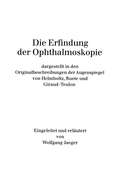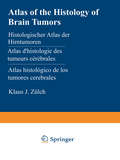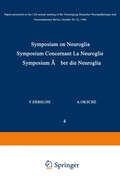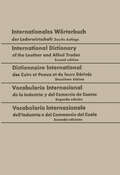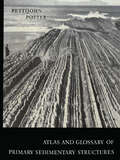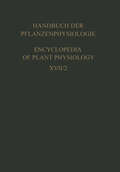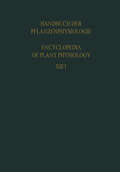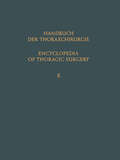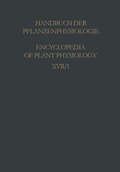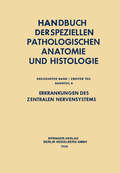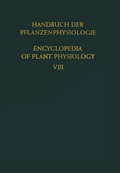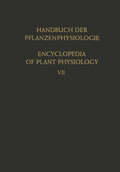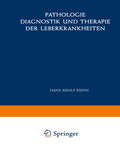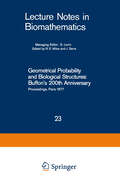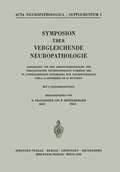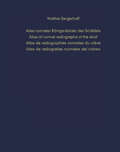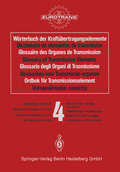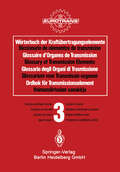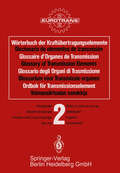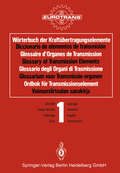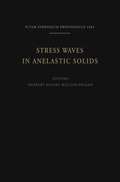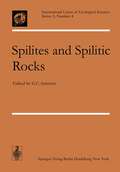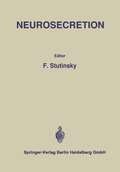- Table View
- List View
Die Erfindung der Ophthalmoskopie: dargestellt in den Originalbeschreibungen der Augenspiegel von Helmholtz, Ruete und Giraud-Teulon
by W. JaegerAtlas of the Histology of Brain Tumors / Histologischer Atlas der Hirntumoren / Atlas d’histologie des tumeurs cérébrales / Atlas histológico de los tumores cerebrales / Гистологический атлас опухолей мозга человека: (pdf)
by K. J. ZülchSymposium on Neuroglia / Symposium Concernant La Neuroglie / Symposium über die Neuroglia: Papers Presented on the 12th Annual Meeting of the Vereinigung Deutscher Neuropathologen und Neuroanatomen Berlin, October 20–22, 1966 (Acta Neuropathologica Supplementa #4)
by F. Erbslöh A. Oksche F. SeitelbergerInternationales Wörterbuch der Lederwirtschaft / International Dictionary of the Leather and Allied Trades / Dictionnaire International des Cuirs et Peaux et de leurs Dérivés / Vocabulario Internacional de la Industria y del Comercio de Cueros / Vocabolario Internazionale dell’Industria e del Commercio del Cuoio: Deutsch — Englisch — Französisch — Spanisch — Italienisch / German — English — French — Spanish — Italian / Allemand — Anglais — Français — Espagnol — Italien / Alemán — Inglés — Francés — Español — Italiano / Tedesco — Inglese — Francese — Spagnolo — Italiano
by Walter FreudenbergAtlas and Glossary of Primary Sedimentary Structures
by F. J. Pettijohn P. E. PotterInadequate observation of sedimentary TRUSHKovA and KUKHARENKO'S "Atlas of structures has been responsible for incorrect Placer Minerals." The most comprehensive interpretation of the order of superposition atlas is the "Atlas of Textures and Struc in deformed beds and this has led, in turn, tures of Sedimentary Rocks" edited by A. to gross errors in stratigraphy and structure. V. KHABAKOV (1962). Failure to recognize and utilize those Our Atlas is an outgrowth of our work on structures which indicate direction of cur "Paleocurrents and Basin Analysis," a book rent flow has also led to incorrect, or at in which directional sedimentary structures least incomplete, understanding of basin are described and interpreted with special development. reference to the evolution of sedimentary We believe, therefore, that there is need for basins. That work, however, contains mini a work which constitutes a field guide to the mal photographic material - just enough study of these structures - a book in to give the reader some concept of the sedi which these structures, so difficult to mentary structures described.
Physiology of Movements / Physiologie der Bewegungen: Part 2: Movements due to the Effects of Temperature, Gravity, Chemical Factors and Internal Factors / Teil2: Bewegungen durch Einflüsse der Temperatur, Schwerkraft, Chemischer Faktoren und aus Inneren Ursachen (Handbuch der Pflanzenphysiologie Encyclopedia of Plant Physiology #17/2)
by E. BünningPlant Respiration Inclusive Fermentations and Acid Metabolism / Pflanzenatmung Einschliesslich Gärungen und Säurestoffwechsel: Part 1 / Teil 1 (Handbuch der Pflanzenphysiologie Encyclopedia of Plant Physiology #12)
by J. WolfEncyclopedia of Thoracic Surgery / Handbuch Der Thoraxchirurgie: Band / Volume 2: Spezieller Teil 1 / Special Part 1
by Charles P. BaileyPhysiology of Movements / Physiologie der Bewegungen: Part 1 Movements due to Mechanical and Electrical Stimuli and to Radiations / Teil 1 Bewegungen durch Einflüsse Mechanischer und Elektrischer Natur Sowie durch Strahlungen (Handbuch der Pflanzenphysiologie Encyclopedia of Plant Physiology #17/1)
by E. BünningErkrankungen des zentralen Nervensystems II: In 2 Teilen (pdf) (Handbuch der speziellen pathologischen Anatomie und Histologie #13 / 2)
by R. BielingDer Stickstoffumsatz / Nitrogen Metabolism (Handbuch der Pflanzenphysiologie Encyclopedia of Plant Physiology #8)
by K. MothesStoffwechselphysiologie der Fette und Fettähnlicher Stoffe / The Metabolism of Fats and Related Compounds (Handbuch der Pflanzenphysiologie Encyclopedia of Plant Physiology #7)
by M. SteinerPathologie, Diagnostik und Therapie der Leberkrankheiten: Viertes Symposion vom 29. Juni bis 1. Juli 1956 (Freiburger Symposion an der Medizinischen Universitäts-Klinik #4)
by Hans A. KühnDieses Symposion über Leberkrankheiten steht unter einem besonderen Stern. Es ist jetzt gerade 30 Jahre her, daß Professor HANS EPPINGER die Leitung dieser Klinik übernahm und vier Jahre in Freiburg gmvirkt hat. Er hat die Patho physiologie der Leberkrankheiten mit seiner ungeheuer weitschauenden und geistvollen Art durchleuchtet und ein Gebäude errichtet, auf dem wir heute weiter bauen. Sein Licht ist in den Sturmesnächten des Kriegsendes erloschen, von vielen unbemerkt, und es ist an der Zeit, daß wir seiner hier in unserem Arbeits kreis gedenken. Ich begrüße bei dieser Gelegenheit ganz besonders seine Tochter, Frau Professor RüHL, sowie die Tochter von Frau RüHL, die Enkelin EPPINGE&s. Ich bin glücklich, daß sie uns die Freude gemacht haben, hier anwesend zu sein. Herr Professor BEIGLBÖCK hat die Aufgabe übernommen, das Lebenswerk EPPINGERs zu würdigen. Ich darf ihm dafür ganz besonders danken. Meine Damen und Herren! Ich darf Sie alle herzlich willkommen heißen und wünschen, daß Sie diese Tage mit Gewinn hier in Freiburg verleben, daß dabei nicht nur das Wissenschaftliche, sondern auch das Gesellige gedeihe, damit der Name "Symposion", den diese Arbeitstagung trägt, auch zu Recht bestehe.
Medical Informatics Europe 81: Third Congress of the European Federation of Medical Informatics Proceedings, Toulouse, France March 9–13, 1981 (Lecture Notes in Medical Informatics #11)
by F. Gremy P. Degoulet B. Barber R. SalamonThe European Federation for Medical Informatics has established itself as a regional body coordinating activity in medical informatics. The Congress in Toulouse, MIE-81, from 9 - 13 March 1981, is the third congress in the ser ies following MIE-78 in Cambr idge, and MIB-79 in Berlin with a gap during 1980 for the world congress MEDINFO-80 in Tokyo. The rationale behind all these congresses is the scientific need to share results and ideas and the educational need to train a wide variety of professional staff in the potential of health care and medical informatics. All the caring professions are involved, doctors, scientists, nurses, para-medical staff, administrators, health care planners, community physicians, epidemiologists, statisticians, operations analysts together with specialists from the computing profession dealing with system analysis, hardware, software, languages, data-bases and the marketing of systems. Medical Informatics is a very wide subject with ramifications throughout the health care and preventive services; it offers a key to the monitoring and improvement of patient care and to the provision of a healthier environment. The collection and evaluation of relevant data improves our understanding of the ways in which health care is provided while the availability of cheaper computer hardware and more versatile software enables us to design and implement more revealing and intelligent medical systems. Even though typical systems take a substantial amount of time to design, implement and evaluate, there is the continuing need for informaticians to assess the current state of developmen.
Geometrical Probability and Biological Structures: Proceedings of the Buffon Bicentenary Symposium on Geometrical Probability, Image Analysis, Mathematical Stereology, and Their Relevance to the Determination of Biological Structures, Held in Paris, June 1977 (Lecture Notes in Biomathematics #23)
by R. E. Miles J. SerraSymposion Über Vergleichende Neuropathologie: Abgehalten von der Arbeitsgemeinschaft für Vergleichende Neuropathologie Während des IV. Internationalen Kongresses für Neuropathologie Vom 4.–8. September 1961 in München (Acta Neuropathologica Supplementa #1)
by E. Frauchiger F. SeitelbergerAtlas normaler Röntgenbilder des Schädels / Atlas of normal radiographs of the skull / Atlas de radiographies normales du crâne / Atlas de radiografias normales del cráneo
by W. BergerhoffWörterbuch der Kraftübertragungselemente / Diccionario de elementos de transmisión / Glossaire des Organes de Transmission / Glossary of Transmission Elements / Glossario degli Organi di Trasmissione / Glossarium voor Transmissie-organen / Ordbok för Transmissionselement / Voimansiirtoalan sanakirja: Band 4 · Zahnradfertigung und -kontrolle / Tomo 4 · Fabricación de engranages y verificatión / Volume 4 · Fabrication des engrenages et contrôle / Volume 4 · Gear Manufacture and Testing / Volume 4 · Fabbricazione degli ingranaggi e loro controllo / Deel 4 · Tandwielfabrikage en kwaliteitskontrole / Band 4 · Produktion och kontroll av kugghjul / Osa 4 · Hammaspyörien valmistus ja tarkastus
by EurotransWörterbuch der Kraftübertragungselemente / Diccionario de elementos de transmisión / Glossaire des Organes de Transmission / Glossary of Transmission Elements / Glossario degli Organi di Trasmissione / Glossarium voor Transmissie-organen / Ordbok för Transmissionselement / Voimansiirtoalan sanakirja: Band 3 · Stufenlos einstellbare Getriebe / Tomo 3 · Variadores de velocidad / Volume 3 · Variateurs de vitesse / Volume 3 · Speed Variators / Volume 3 · Variatori di velocità / Deel 3 · Regelbare aandrijvingen (variatoren) / Band 3 · Steglöst inställbara växlar / Osa 3 · Portaattomasti säädettävät vaihteet
by EurotransWörterbuch der Kraftübertragungselemente / Diccionario elementos de transmisión / Glossaire des Organes de Transmission / Glossary of Transmission Elements / Glossario degli Organi di Trasmissione / Glossarium voor Transmissie-organen / Ordbok för Transmissionselement / Voimansiirtoalan sanakirja: Band 2 · Zahnradgetriebe / Tomo 2 · Reductores de engranajes / Volume 2 · Ensembles montés à base d’engrenages / Volume 2 · Gear Units / Volume 2 · Riduttori di velocità ad ingranaggi / Deel 2 · Tandwielkasten / Band 2 · ·Kuggväxlar / Osa 2 · Hammasvaihteet
by EurotransWörterbuch der Kraftübertragungselemente / Diccionario de elementos de transmisión / Glossaire d’Organes de Transmission / Glossary of Transmission Elements / Glossario degli Organi di Trasmissione / Glossarium voor Transmissie-organen / Ordbok för Transmissionselement / Voimansiirtoalan sanakirja: Band 1 · Zahnräder / Tomo 1 · Ruedas dentadas / Volume 1 · Engrenages / Volume 1 · Gears / Volume 1 · Ingranaggi / Deel 1 · Tandwielen / Band 1 · Kugghjul / Osa 1 · Hammaspyörät
by EurotransStress Waves in Anelastic Solids: Symposium Held at Brown University, Providence, R. I., April 3–5, 1963 (IUTAM Symposia)
by Herbert Kolsky William PragerAlthough the subject of wave propagation in solids has a long history, the classical theory of elastic waves having been developed in the nine teenth century by STOKES, POISSON, RAYLEIGH and KELVIN, the last two decades have seen a remarkable revival of interest in this subject among both theoreticians and experimenters. There' are a number of reasons for this; first, experimental methods for the generation and detection of high frequency mechanical waves have become available only with the advent of electronic techniques and of high speed photo graphic recording apparatus. Secondly, the appearan
Spilites and Spilitic Rocks (International Union of Geological Sciences #4)
by G. C. AmstutzThe idea for the present Spilite Volume was born during the Spilite Symposium at the XXIIIrd session of the International Geological Con gress in Prague, 1968. At that time, only a restricted number of petro logists working on spilites was present and, therefore, the group assem bled agreed that a Symposium Volume should also include recent papers by many other spilite specialists. At the same time it was agreed that the papers presented at the Symposium should be returned to the authors for changes and additions. This procedure of upgrading and amending the papers has continued until this year (1973) for various technical and editorial reasons. The information presented here is, therefore, up-to date. To those familiar with the spilite problem it is obvious that the time had come for a review of its state. Also, the existing litera ture had become so voluminous that a monographic review was necessary. Following a modern trend, the authorship for this review was spread among specialists with variable experience. For readers not necessarily familiar with the spilite problem, a brief summary is presented here. A short historical note is followed first by the observations, then by the interpretations, finally by some of the major features of scientific logic as they pertain to the problem of the primary or secondary origin of some of the rocks termed spilites and keratophyres.
Neurosecretion: IV. International Symposium on Neurosecretion / IVe Symposium International sur la Neurosécrétion
by F. StutinskyMultiple Criteria Decision Making: Proceedings of a Conference Jouy-en-Josas, France May 21–23, 1975 (Lecture Notes in Economics and Mathematical Systems #130)
by H. Thiriez S. ZiontsThe conference was organized in order to assemble a group of researchers and practitioners in the area of Multiple Criteria Decision Making. The purpose was to discuss the current state of the art with respect to both theory and practice. This conference considered such points as recent t_heoretical developments in terms of models, the behavioral aspects of multiple criteria decision making, as well as practical applications already realized and 1n progress. In addition, there was interest in the problems of implementation of multiple-criteria methods, and the interface between theory and practice, Approximately 78 participants from 15 different countries attended the conference - both theorists and practitioners. A list of participants and their addresses is found on page 411 • Because of the relatively large number of papers presented, large morning sessions followed by smaller parallel afternoon sessions were employed'. In general a discussant commented on each paper. In addition, considerable time was reserved for small-group discussion and interaction. In addition to expressing our gratitude to the participants for their enthusiastic reception and participation in the conference, we want. to thank particularly the speakers, session chairmen and discussants. We also wish to thank the C.E.S.A. and the European Institute for their support, as well as Mrs. Randee Pomerantz and Miss Dina Nagler.~oth of the E.I.A.S.M.,for their active role in the organization and arrangements for the conference, and Mrs. Jessie Goveas, E.I.A.S.M. for typing the conference proceedings.
